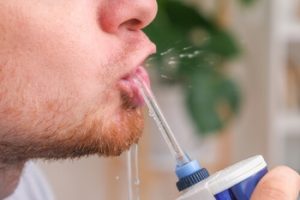Water flossing has surged in popularity as an essential component of oral health routines, but how often should you use a water flosser? This question swirls amidst a sea of dental advice, leaving many wondering if their efforts to maintain a healthy smile are adequate. As we navigate the intricate details of water flossing, gum disease, and overall oral hygiene, let’s explore the detailed best practices for maintaining optimal oral health and keeping your teeth in excellent condition.
Water Flossing: What You Need to Know
Water flossing, also known as oral irrigating, involves using a specialised device to spray a stream of water between teeth and along the gum line. This method is specifically beneficial for individuals with braces, dental implants, or periodontal disease, as it can navigate tight spaces and gum pockets more effectively.
Why Water Flossing Should Be Your New Best Friend
 Maintaining good oral health is the cornerstone to preventing a host of dental issues, from tooth decay to gum disease. Water flossers have emerged as a formidable ally in the fight against oral health problems.
Maintaining good oral health is the cornerstone to preventing a host of dental issues, from tooth decay to gum disease. Water flossers have emerged as a formidable ally in the fight against oral health problems.
- Effective Plaque Removal: Water flossers can remove plaque and bacteria from hard-to-reach areas, reducing the risk of gum disease and tooth decay.
- Gentle on Gums: For individuals with sensitive gums or periodontal disease, water flossers offer a gentler alternative to traditional string floss.
- Convenient for Orthodontic Treatment: Individuals with braces or dental implants find water flossers easier to use, as they can clean around wires and brackets more effectively.
So, How Often Should You Waterfloss?
The recommended frequency for water flossing can vary based on individual needs and dental health conditions. Most dentists and dental professionals suggest incorporating water flossing into your daily routine to maintain good oral health. For optimal results, it’s advisable to use a water flosser at least once a day, ideally before bedtime, to ensure that food debris and plaque are removed from your entire mouth.
For Those With Special Dental Needs:
- Braces or Orthodontic Treatment: Water flossing twice a day can be beneficial, as it helps to remove debris that gets trapped in the braces.
- Dental Implants: Using a water flosser with an implant denture tip can aid in cleaning around implants and prevent plaque buildup.
- Gum Disease or Periodontal Issues: Those with gum pockets or periodontal disease might find water flossing twice daily helpful in managing their condition.
The Science Behind Water Flossing: How It Works Wonders
Water flossers use a pulsating stream of water to effectively clean the spaces between teeth and below the gum line, which can be more effective than traditional flossing in certain scenarios. The pressure and pulsation of the water help dislodge food particles and plaque while also massaging the gums to improve gum health.
Key Points to Consider:
- Water Temperature: Using warm water can make the process more comfortable, especially for those with sensitive gums.
- Pressure Settings: Start with less pressure and gradually increase as your gums get used to the sensation.
- Water Flosser Tips: Different tips are available for various needs, such as orthodontic tips for braces or implant tips for dental work.
Water Flossing vs. Traditional Flossing: Which is Right for You?
The debate between water flossing and traditional flossing is ongoing, with each method offering unique benefits. Traditional string floss is effective for removing plaque and food particles from between teeth, while water flossers can reach areas that string floss might miss.
Pros of Traditional Flossing:
- Direct Contact: String floss makes direct contact with tooth surfaces, which can be effective in scraping off plaque.
- Portable: Dental floss is easy to carry and use anywhere.
Pros of Water Flossing:
- Ease of Use: Water flossers are more user-friendly for individuals with braces, dental implants, or those who have limited dexterity.
- Comprehensive Cleaning: The water stream can reach areas that string floss might not, such as under dental work or around orthodontic appliances.
Making Water Flossing Part of Your Daily Routine
To reap the benefits of water flossing, it’s essential to integrate it into your daily oral hygiene routine. Here are some tips to help you get started:
- Choose the Right Water Flosser: There are various models available, including countertop and cordless models. Choose one that matches your lifestyle and needs.
- Fill the Reservoir with Warm Water: Warm water can enhance comfort, especially for sensitive gums.
- Select the Appropriate Tip: Use tips designed for your specific dental needs, such as orthodontic tips for braces or periodontal tips for gum pockets.
- Adjust the Pressure: Start with a lower pressure setting and gradually increase it as you become more comfortable.
- Follow a Systematic Approach: Begin at the back of your mouth and work your way forward, ensuring you cover all areas, including hard-to-reach places.
Beyond Water Flossing: Mastering Comprehensive Oral Hygiene
While water flossing is a powerful tool in maintaining good oral health, it should be part of a comprehensive oral hygiene routine. Regular brushing with an electric toothbrush, using dental tape or conventional floss, and routine visits to the dentist are crucial components of maintaining a healthy smile.
Additional Oral Hygiene Tips:
- Brush Twice a Day: Use a fluoride toothpaste and brush for at least two minutes.
- Regular Flossing: Complement water flossing with traditional string flossing to ensure thorough cleaning.
- Dental Check-ups: Visit your dental professional frequently for check-ups and professional cleanings.
- Healthy Diet: A diet rich in fruits, vegetables, and dairy products can support dental health.
- Avoid Tobacco: Smoking and chewing tobacco can harm your gums and teeth.
Debunking Common Myths About Water Flossing
With water flossing gaining traction, several myths and misconceptions have emerged. Let’s set the record straight on a few of these common misunderstandings:
Myth 1: Water Flossers Can Replace Brushing
- Reality: While water flossers are excellent for removing plaque and food particles between teeth, they do not replace the need for brushing. Brushing removes surface plaque from teeth and freshens breath.
Myth 2: Water Flossing is Too Messy
- Reality: Modern water flossers are designed to minimise mess. By leaning over the sink and adjusting the pressure, you can control the water flow and prevent splashing.
Myth 3: Water Flossing is Only for People with Braces
- Reality: While water flossing is particularly beneficial for those with braces, it is suitable for anyone looking to enhance their oral hygiene routine. It’s effective for people with dental implants, bridges, or anyone who finds traditional flossing challenging.
Expert Tips for Maximising Your Water Flossing Routine
To ensure you’re getting the most out of your water flosser, consider these expert tips:
Start Slow: Begin with the lowest pressure setting and gradually increase it as you get comfortable.
Aim Carefully: Direct the water stream at a 90-degree angle to your gum line for optimal cleaning.
Move Methodically: Work your way around your mouth systematically, ensuring you don’t miss any areas.
Water Flossing for Special Populations
Certain groups of people may benefit more significantly from water flossing. Here’s how it can help:
- Children and Teens
- Ease of Use: Water flossers can be easier for kids and teens to use, especially those with braces.
- Fun Factor: The novelty of using a water flosser might encourage better oral hygiene habits.
- Elderly Individuals
- Accessibility: For older adults with arthritis or dexterity issues, water flossers offer an easier and more comfortable option compared to traditional floss.
- Pregnant Women
- Gum Sensitivity: Pregnancy can increase gum sensitivity and the risk of gum disease. Water flossers provide a gentle way to maintain oral health during this time.
Addressing Common Concerns and Questions
- Can Water Flossers Damage My Teeth or Gums?
- Gentle on Gums: When used correctly, water flossers are gentle and can actually improve gum health by reducing inflammation and bleeding.
- How Long Should I Use a Water Flosser Each Session?
- Timing It Right: Typically, one minute of water flossing is sufficient, but this can vary depending on individual needs and preferences.
- Do Water Flossers Remove Plaque as Effectively as Traditional Floss?
- Complementary Tools: Both methods are effective in removing plaque. Using them together can provide a comprehensive cleaning.
Making the Switch: Transitioning from Traditional Floss to Water Flossing
If you’re considering making the switch to water flossing, here’s a step-by-step guide:
- Start with Both
- Dual Approach: Begin by using both traditional floss and a water flosser to get a feel for each method.
- Observe the Benefits
- Notice Improvements: Pay attention to how your gums feel and the cleanliness of your teeth. Many people notice less bleeding and inflammation with water flossing.
- Gradually Transition
- Phased Approach: Gradually rely more on the water flosser, especially if you find it more comfortable and effective.
Wrapping It All Up: Water Flossing for a Brilliant Smile
 Water flossing is a valuable addition to any oral hygiene routine, offering numerous benefits for maintaining gum health and preventing dental issues. By understanding how often to water floss and integrating it into your daily routine, you can enhance your overall dental health and enjoy a healthy, vibrant smile.
Water flossing is a valuable addition to any oral hygiene routine, offering numerous benefits for maintaining gum health and preventing dental issues. By understanding how often to water floss and integrating it into your daily routine, you can enhance your overall dental health and enjoy a healthy, vibrant smile.
Remember, the key to good oral health lies in consistency. Whether you choose traditional string floss, a water flosser, or a combination of both, the most important thing is to floss regularly and visit your dental professional for personalised advice and care. With the right strategy, you can achieve and maintain a healthy mouth for years to come.
For further guidance and to maintain your oral health, contact Beyond Infinity Dental (Denfinity) at (02) 8806 3799. Our team is here to assist you with all your dental needs.
Sources
Cleveland Clinic. (n.d.). Teeth braces. Retrieved from https://my.clevelandclinic.org/health/treatments/24601-teeth-braces
Centers for Disease Control and Prevention. (n.d.). Gum (periodontal) disease. Retrieved from https://www.cdc.gov/oral-health/about/gum-periodontal-disease.html
WebMD. (n.d.). What is a Waterpik? Retrieved from https://www.webmd.com/oral-health/what-is-waterpik
FDI World Dental Federation. (n.d.). How to practice good oral hygiene. Retrieved from https://www.fdiworlddental.org/how-practice-good-oral-hygiene









